《动物免疫学》课程PPT教学课件(讲稿)细胞因子 Cytokines
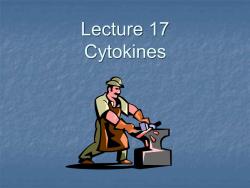
Lecture 17 Cytokines
Lecture 17 Cytokines
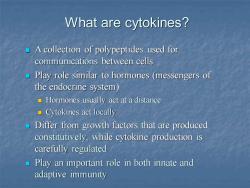
What are cytokines? A collection of polypeptides used for communications between cells Play role similar to hormones(messengers of the endocrine system) Hormones usually act at a distance Cytokines act locally Differ from growth factors that are produced constitutively,while cytokine production is carefully regulated Play an important role in both innate and adaptive immunity
What are cytokines? ◼ A collection of polypeptides used for communications between cells ◼ Play role similar to hormones (messengers of the endocrine system) ◼ Hormones usually act at a distance ◼ Cytokines act locally ◼ Differ from growth factors that are produced constitutively, while cytokine production is carefully regulated ◼ Play an important role in both innate and adaptive immunity
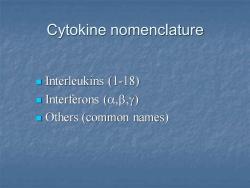
Cytokine nomenclature Interleukins (1-18) Interferons(a,β,Y) Others (common names)
Cytokine nomenclature ◼ Interleukins (1-18) ◼ Interferons (a,b,g) ◼ Others (common names)
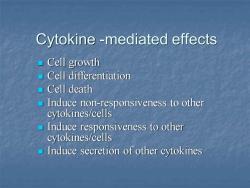
Cytokine -mediated effects Cell growth Cell differentiation Cell death Induce non-responsiveness to other cytokines/cells Induce responsiveness to other cytokines/cells Induce secretion of other cytokines
Cytokine -mediated effects ◼ Cell growth ◼ Cell differentiation ◼ Cell death ◼ Induce non-responsiveness to other cytokines/cells ◼ Induce responsiveness to other cytokines/cells ◼ Induce secretion of other cytokines

How do cytokines tell cells what to do? Produced by cells as part of normal cellular activity and/or the result of environmental trigger Bind to receptors on cells Trigger signal transduction pathways Initiate synthesis of new proteins
How do cytokines tell cells what to do? ◼ Produced by cells as part of normal cellular activity and/or the result of environmental trigger ◼ Bind to receptors on cells ◼ Trigger signal transduction pathways ◼ Initiate synthesis of new proteins
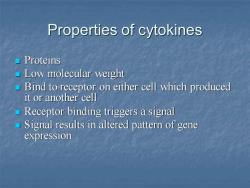
Properties of cytokines Proteins Low molecular weight 口 Bind to receptor on either cell which produced it or another cell Receptor binding triggers a signal Signal results in altered pattern of gene expression
Properties of cytokines ◼ Proteins ◼ Low molecular weight ◼ Bind to receptor on either cell which produced it or another cell ◼ Receptor binding triggers a signal ◼ Signal results in altered pattern of gene expression

Cytokines can act in three different manners Autocrine Cytokine binds to receptor on cell that secreted it Paracrine Cytokine binds to receptors on near by cells Endocrine Cytokine binds cells in distant parts of the body
Cytokines can act in three different manners ◼ Autocrine ◼ Cytokine binds to receptor on cell that secreted it ◼ Paracrine ◼ Cytokine binds to receptors on near by cells ◼ Endocrine ◼ Cytokine binds cells in distant parts of the body

Cytokine Actions Pleiotropy Act on more than one cell type (INFa/B) Redundancy More than one cytokine can do the same thing (IFNo/βand IFNy) 口 Synergy Two or more cytokines cooperate to produce an effect that is different or greater than the combined effect of the two cytokines when functioning separately (IL-12 and IL-8) Antagonism Two or more cytokines work against each other (IL-4 and IL-12)
Cytokine Actions ◼ Pleiotropy ◼ Act on more than one cell type (INFa/b) ◼ Redundancy ◼ More than one cytokine can do the same thing (IFNa/b and IFNg) ◼ Synergy ◼ Two or more cytokines cooperate to produce an effect that is different or greater than the combined effect of the two cytokines when functioning separately (IL-12 and IL-8) ◼ Antagonism ◼ Two or more cytokines work against each other (IL-4 and IL-12)
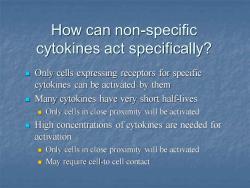
How can non-specific cytokines act specifically? Only cells expressing receptors for specific cytokines can be activated by them Many cytokines have very short half-lives Only cells in close proximity will be activated High concentrations of cytokines are needed for activation Only cells in close proximity will be activated May require cell-to cell contact
How can non-specific cytokines act specifically? ◼ Only cells expressing receptors for specific cytokines can be activated by them ◼ Many cytokines have very short half-lives ◼ Only cells in close proximity will be activated ◼ High concentrations of cytokines are needed for activation ◼ Only cells in close proximity will be activated ◼ May require cell-to cell contact
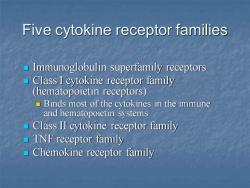
Five cytokine receptor families Immunoglobulin superfamily receptors Class I cytokine receptor family (hematopoietin receptors) Binds most of the cytokines in the immune and hematopoietin systems Class II cytokine receptor family TNF receptor family Chemokine receptor family
Five cytokine receptor families ◼ Immunoglobulin superfamily receptors ◼ Class I cytokine receptor family (hematopoietin receptors) ◼ Binds most of the cytokines in the immune and hematopoietin systems ◼ Class II cytokine receptor family ◼ TNF receptor family ◼ Chemokine receptor family
按次数下载不扣除下载券;
注册用户24小时内重复下载只扣除一次;
顺序:VIP每日次数-->可用次数-->下载券;
- 《动物免疫学》课程PPT教学课件(讲稿)B细胞的生物学(Biology of the B Lymphocyte).ppt
- 《动物免疫学》课程PPT教学课件(讲稿)B细胞对抗原的识别和应答.ppt
- 《动物免疫学》课程PPT教学课件(讲稿)Antigen Recognition.ppt
- 《动物免疫学》课程PPT教学课件(讲稿)Antibody-Antigen Reactions.ppt
- 《动物免疫学》课程教学资源(文献资料)补体 Complement(英文)1.pdf
- 《动物免疫学》课程教学资源(文献资料)补体 Complement(英文)2.pdf
- 《动物免疫学》课程教学资源(文献资料)补体调节蛋白(英文).pdf
- 《动物免疫学》课程教学资源(文献资料)补体缺陷性疾病(英文).pdf
- 《动物免疫学》课程教学资源(文献资料)补体的检测法(英文).pdf
- 《动物免疫学》课程教学资源(文献资料)补体激活的经典途径(英文).pdf
- 《动物免疫学》课程教学资源(文献资料)补体激活的末端途径(英文).pdf
- 《动物免疫学》课程教学资源(文献资料)补体激活的旁路途径(英文).pdf
- 《动物免疫学》课程教学资源(文献资料)补体受体(英文).pdf
- 《动物免疫学》课程教学资源(文献资料)抗微生物蛋白和肽(英文).pdf
- 《动物免疫学》课程教学资源(文献资料)抗原递呈给淋巴细胞(英文).pdf
- 《动物免疫学》课程教学资源(文献资料)抗原被淋巴细胞识别(英文).pdf
- 《动物免疫学》课程教学资源(文献资料)抗原抗体结合(英文).pdf
- 《动物免疫学》课程教学资源(文献资料)抗原处理过程(英文).pdf
- 《动物免疫学》课程教学资源(文献资料)抗体(英文).pdf
- 《动物免疫学》课程教学资源(文献资料)免疫系统的细胞(英文).pdf
- 《动物免疫学》课程PPT教学课件(讲稿)IL-8生物活性的检测.ppt
- 《动物免疫学》课程PPT教学课件(讲稿)Cellular Cooperation and Antigen Recognition.ppt
- 《动物免疫学》课程PPT教学课件(讲稿)T淋巴细胞与特异性细胞免疫.ppt
- 《动物免疫学》课程PPT教学课件(讲稿)主要的补体系统缺乏(Primary deficiencies of the complement system).ppt
- 《动物免疫学》课程PPT教学课件(讲稿)主要组织相容性复合体及其编码分子.ppt
- 《动物免疫学》课程PPT教学课件(讲稿)主要组织相容性抗原系统(histicompatibility antigen).ppt
- 《动物免疫学》课程PPT教学课件(讲稿)传染与免疫(病原体对机体的感染、机体对感染的预防和治疗).ppt
- 《动物免疫学》课程PPT教学课件(讲稿)体液免疫反应 Humoral Immune Response.ppt
- 《动物免疫学》课程PPT教学课件(讲稿)免疫学发展简史及展望.ppt
- 《动物免疫学》课程PPT教学课件(讲稿)免疫学概论.ppt
- 《动物免疫学》课程PPT教学课件(讲稿)免疫应答概述(Immune response).ppt
- 《动物免疫学》课程PPT教学课件(讲稿)免疫标记技术及应用.ppt
- 《动物免疫学》课程PPT教学课件(讲稿)免疫球蛋白(Immunoglobulin, Ig).ppt
- 《动物免疫学》课程PPT教学课件(讲稿)免疫系统(The Immune System).ppt
- 《动物免疫学》课程PPT教学课件(讲稿)免疫系统的遗传学(Genetics of the Immune system).ppt
- 《动物免疫学》课程PPT教学课件(讲稿)免疫耐受 Immunological Tolerance.ppt
- 《动物免疫学》课程PPT教学课件(讲稿)免疫自动化仪器分析.ppt
- 《动物免疫学》课程PPT教学课件(讲稿)抗原(Antigen, Ag).ppt
- 《动物免疫学》课程PPT教学课件(讲稿)抗体-抗原反应(Antibody-Antigen Reactions).ppt
- 《动物免疫学》课程PPT教学课件(讲稿)抗体产生的多样性(英文).ppt
